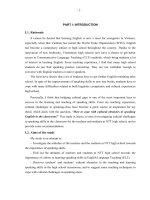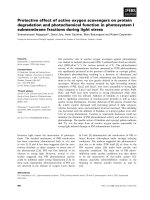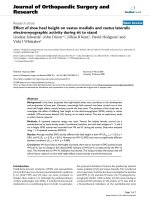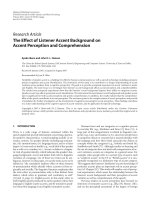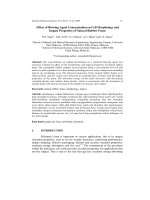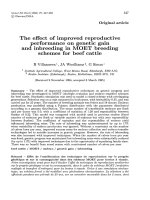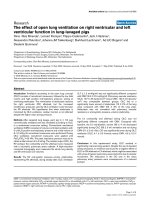The Effect Of Teaching Grammar Communicatively On Students’ Grammatical And Communicative Competence At Nguyen Tat Thanh University
Bạn đang xem bản rút gọn của tài liệu. Xem và tải ngay bản đầy đủ của tài liệu tại đây (260.15 KB, 49 trang )
Ho Chi Minh City Open University
Graduate School
97 Vo Van Tan Street, District 3, HCMC, Vietnam
Student’s name
: NGUYEN THI HOANG TRINH
Student No.
: 1781401110040
Class code
:
Email address
:
Course name
:
THE EFFECT OF TEACHING GRAMMAR
Title of this item
COMMUNICATIVELY ON STUDENTS’ ORAL
:
work:
COMMUNICATION SKILLS AT NGUYEN TAT
THANH UNIVERSITY
Lecturer’s name
:
Due date
:
STATEMENT OF AUTHORSHIP:
I certify that the assignment is my original work; it is based on my own research. No other
person’s work has been used without due acknowledgement. This piece of work has not
previously been submitted for assessment in this or any other subject or course at this University
The Effect Of Teaching Grammar Communicatively On Students’ Grammatical And
Communicative Competence At Nguyen Tat Thanh University
THE EFFECT OF TEACHING GRAMMAR COMMUNICATIVELY ON STUDENTS’
GRAMMATICAL AND COMMUNICATIVE COMPETENCE AT NGUYEN TAT THANH
UNIVERSITY
Ho Chi Minh City Open University
1
The Effect Of Teaching Grammar Communicatively On Students’ Grammatical And
Communicative Competence At Nguyen Tat Thanh University
2
The Effect Of Teaching Grammar Communicatively On Students’ Grammatical And
Communicative Competence At Nguyen Tat Thanh University
Table of Content
s
INTRODUCTION...........................................................................................................................3
Research Question:......................................................................................................................5
Definitions of terms..................................................................Error! Bookmark not defined.5
Delimitations and Limitations of the Study.............................Error! Bookmark not defined.6
LITERATURE REVIEW............................................................Error! Bookmark not defined.6
Previous research.......................................................................................................................25
METHODOLOGY....................................................................Error! Bookmark not defined.10
Study Design..........................................................................Error! Bookmark not defined.10
Research site and Participants....................................................................................................10
Instruments.................................................................................................................................10
Procedures..................................................................................................................................30
Validity and Reliability..............................................................................................................13
Data analysis..............................................................................................................................13
TIME LINE................................................................................Error! Bookmark not defined.14
References..................................................................................Error! Bookmark not defined.16
3
The Effect Of Teaching Grammar Communicatively On Students’ Grammatical And
Communicative Competence At Nguyen Tat Thanh University
APPENDICES...............................................................................................................................35
4
The Effect Of Teaching Grammar Communicatively On Students’ Grammatical And
Communicative Competence At Nguyen Tat Thanh University
CHAPTER 1
1.1 INTRODUCTION
1.2 Background to the study
Throughout the years grammar has been playing an important role in teaching English as
a second and foreign language. Grammar can be defined as “the whole system and structure of a
language or of languages in general, usually taken as consisting of syntax and morphology
(including
inflections)
and
sometimes
also
phonology
and
semantics.”
( A futher definition is given by Rutherford (1987) who
describes grammar as “a necessary component of any language teaching program”. According to
Brown (2007), language is chaotic and unintelligible without grammar. In the history of EFL
teaching method, a variety of grammar teaching methods have been introduced and implemented
in the hope that learners can enhance their competence in a foreign language. Typically, first of
all, Grammar-Translation Method (GTM) which is described as one of the oldest and traditional
method of teaching is based on analysis of the written language using translation exercises,
reading comprehension and written imitation of texts. Learning mainly involves the mastery of
grammatical rules and memorization of vocabulary lists. The Direct Method (DM) of teaching
was developed as a response to the GTM. It is based on the active involvement of the learner in
both speaking and listening to the new language in realistic everyday situations. The process
consists of a gradual acquisition of grammatical structure and vocabulary. The learner is
encouraged to think in the target language rather than translate. He or she hears and uses the
language before seeing it written. Similar to Direct Method, the Audio-lingual method (ALM)
advised that students should be taught a language directly, without using the students’ native
language to explain new words or grammar in the target language. However, unlike the direct
5
The Effect Of Teaching Grammar Communicatively On Students’ Grammatical And
Communicative Competence At Nguyen Tat Thanh University
method, the audio-lingual method did not focus on teaching vocabulary. Rather, the teacher
drilled students in the use of grammar ( />Due to the increase in demand for language learning, the introduction of Communicative
Language Teaching (CLT) was in response to the lack of success with language teaching
methods proceeding it. So far CLT has become prominent as it proposed an alternative to the
former methods. It switched traditional language teaching’s emphasis on grammar, and the
teacher-centred classroom to that of the active use of authentic language in learning and
acquisition. This means that it places less focus on the learning of specific grammatical rules and
more on developing the learners’ communicative competence in the target language with real-life
situations. Moreover, it highlights learners as center of instruction. The teacher’s role has
changed when compared to previous methods. The teachers talk less and listen more to the
students. They no longer control all activities in classroom, instead, they ask the students to take
part in meaningful communication. Communicative itself has own advantages and it truly
provides learners benefits in various ways. In this paper, the term communicative grammar
teaching is used to refer to teaching grammar communicatively.
In spite of the importance of communication skill, it can not be denied that grammar lays
the groundwork for effective communication. Grammatical competence is a part of
communicative competence; in order to obtain effective communication people should
concentrate on grammar. Similarly, Nunan (1991) states that learners can not communicate well
if they do not know the basic grammar. Recently, therefore, there have been many new issues
and ideas concerning the importance of the relationship between grammar and oral
communication skill. The disagreement about methods of teaching grammar has developed in the
ongoing past, but the question stays as to the effectiveness of various methods.
6
The Effect Of Teaching Grammar Communicatively On Students’ Grammatical And
Communicative Competence At Nguyen Tat Thanh University
1.3 Statement of the problem
Vietnam has been considered as a developing country with many potentials, which
explains why English has been so dominant. Therefore, many Vietnamese educators have shown
an increasing interest in teaching English as a foreign language taught in Vietnam. In Vietnam,
however, teaching English is not easy because the term of English and Vietnamese are
distinctive. English language is taught mainly by Vietnamese teachers and English appears to be
taught through Vietnamese as the medium of instructions. The lessons are limited to grammatical
points and comprehension reading which require heavy explanations via use of mother tongues.
In the past decades English has become a global language which is considered as an
opportunity door for a better future life. In fact, in spite of its incredible importance, there is
always a big obstacle that make communication skill of Vietnamese students challenging. There
are some explanations for this undeniable fact. First of all, the teaching of English in secondary
and high schools strongly focus mainly on grammar, sentence structures and vocabulary. In
addition, English learning and teaching is purely examination-based which are mainly grammar
focused. As a result, Vietnamese students eventually fail to see the importance of English. Due to
the fact that most students only study English to pass school exams, they are not high-motivated
and are prevented from the opportunities to practice English in real life situations. They might
master every aspect of grammar points and succeed in written examinations; however, they can
not connect those grammar points with larger communication contexts. There is another reason
for which students fail to improve the command of English, particularly fail to achieve fluency in
English. It is all the embarrassment or lack of confidence that prevents them from speaking. This,
eventually, will result in forgetting what they have already learned. This is the big problem with
7
The Effect Of Teaching Grammar Communicatively On Students’ Grammatical And
Communicative Competence At Nguyen Tat Thanh University
a lot of students no matter how large the amount of vocabulary and grammatical points they have
gained.
Last but not least we can not deny the significantly important role of teaching methods
that teachers use in classrooms. There is no single methodology that can consistently be
considered the best. The correct approach is the one that meets the learners’ objectives and can
be implemented in learners’ environment. A global challenge EFL teachers face with respect to
pedagogical approaches to teaching grammar is how to “bridge the gap between traditional
teaching focused on grammar translation and receptive skills and communicative teaching aimed
at well-rounded communication skills (Stephen, 2012). Sadly, however, there is a common
reality that the researcher has experienced during over five years of teaching English at Tan Phu
high school and Ngyen Tat Thanh University, through examining my own practice, observing
most of my colleagues, and discussion about the thoughts and ideas about teaching learning with
each other. In spite of the awareness of the great impact of teaching method, most of them do
enjoy being the ‘sage on the stage’ and feel confident in their present style of teaching. It means
they are satisfied with the application of Grammar Translation Method to teach grammar without
taking into account the fact that their students can not use the language for communication. They
admit that their preference for GTM derives from its demand for fewer efforts from teachers.
Teachers who are not fluent in speaking English can teach it easily through this method. Even
some of them who have a deep understanding of the advantages of CLT over GTM show their
great reluctance to apply CLT in the classroom. They state it requires teachers to make much
greater effort in GTM classroom. For students, when being asked about their experience in
traditional grammar lessons, most of them state that what they learn is a series of grammatical
structures provision followed by mechanical practice in the form of isolated sentences, which
8
The Effect Of Teaching Grammar Communicatively On Students’ Grammatical And
Communicative Competence At Nguyen Tat Thanh University
only serves conventional grammar-paper tests. Consequently, though they have considerable
knowledge of grammar, they can not use English to communicate, even in simple situation like
personal introduction.
That is the reason why language teaching methods have changed dramatically over time.
As mentioned in previous part, one of the oldest and traditional method, Grammar Traditional
Method, whose focus is on formal knowledge of the language, specifically nowadays has been
replaced with others because of its weaknesses. The latter methods (Direct Method, Audio
Lingual Method, Communicative Language Teaching, emerged as a response to the perceived
inability of the preceding one to teach learners to communicate. It is important to note that each
of them has their own advantages and disadvantages.
1.4 Aims of the study
Based on the problems above, there are two primary aims of this study. Firstly, this study
is conducted to investigate whether students get a greater achievement in English grammatical
knowledge and communicative competence with the instruction of the communicative grammar
9
The Effect Of Teaching Grammar Communicatively On Students’ Grammatical And
Communicative Competence At Nguyen Tat Thanh University
teaching from teachers. Secondly, this paper will make contributions to develop a sharp
understanding of students’ attitudes towards this teaching method.
It is the central issue for the language educators to choose the most feasible way. Some
language specialists think that for language students, meaning should be more emphasized than
the form and the instructors should teach the language in order to convey meaning and for
communication (Prabhu, 1987). This contrasts with that of some others (Dickins and Woods,
1988) who had the argument that being competent about the grammatical structures of a specific
language is very critical in light of the fact that grammatical competence is recognized equivalent
to being fluent in communicative skills. In such manner, teachers who have a conventional
perspective on language teaching may utilize deductive method to present the structures;
notwithstanding, the ones who concede that students can secure the language without grammar
instruction may use inductive method as language teaching. Nonetheless, there is not a general
agreement about the effectiveness of grammar teaching. Accordingly, the motivation behind this
study is to investigate the effect of Communicative Language Teaching on students’ grammatical
and communicative competence.
1.5 Research Questions
In order to achieve the above purposes, this study aims to address the following research
questions:
Does teaching grammar communicatively have any effect on students’ achievement of
grammatical knowledge and oral communication skills?
What are the students’ attitudes towards the communicative grammar teaching method?
1.6 Scope of the study
10
The Effect Of Teaching Grammar Communicatively On Students’ Grammatical And
Communicative Competence At Nguyen Tat Thanh University
In order to achieve the purpose of this study is to investigate whether or not
communicative grammar activities enhance students’ grammar knowledge and oral production.
The study concentrates on the 70 samples which are first-year students at Nguyen Tat Thanh
Institute of International Education in 2020-2021 academic year. The samples are selected for the
following reason. In my more than 2 years of teaching as an English teacher, I have worked with
hundreds of students at college level. From my observation, I have realized that the ability to
speak English seems to be impossible for most students who are not majoring in English
language. Therefore, the focus of the study is on freshmen who are non-English major students at
Nguyen Tat Thanh.
1.7 Significance of the study
This study provides an important opportunity to advance the understanding of
communicative grammar teaching techniques as an alternative to the existing traditional ones. It
will help EFL teachers and educators recognize the problems they might face in the process of
teaching, and might apply communicative language teaching method in order to enhance
students' oral communication skills. This study also helps learners to express themselves in
communication and makes them active participants in the learning of grammar items in the
classroom.
1.8 Organization of the Thesis
The overall structure of the study takes the form of three chapters, including this
introductory chapter which consists of Statement of the Problem, Significance of the Study,
Scope of the Study, Organization of the Thesis. Chapter two begins by laying out the review of
11
The Effect Of Teaching Grammar Communicatively On Students’ Grammatical And
Communicative Competence At Nguyen Tat Thanh University
related literature in which important issues related to communicative grammar. The third chapter
is concerned with the methodology used for this study.
2. LITERATURE REVIEW
2.1. INTRODUCTION
This chapter reviews the literature related to the study. It first presents some definitions
of key terms; an overview of communicative language teaching and some of its importance
characteristics. Finally, the chapter reviews studies that have been reported on the target teaching
method and students’ attitudes towards communicative activities.
2.2
DEFINITION OF KEY TERMS
2.2.1 Attitude
The concept "attitude" is one that has been frequently studied in social science.
According to Longman Dictionary, ‘attitude’ is defined as “the opinions and feelings that you
usually have about something” and “the way that you behave towards someone or in a particular
situation, especially when this shows how you feel”.
An attitude can be also defined as an evaluation of an attitude object ranging from
extremely negative to extremely positive ( In
the similar way, psychologists (e.g. Hockenbury, 2007; Myers, 1999; Smith and Mackie, 2007)
define attitudes as a learned tendency to evaluate things in a certain way. This can include
evaluations of people, issues, objects or events. Such evaluations are often positive or negative,
but they can also be uncertain at times. For example, you might have mixed feelings about a
particular person or issue.
12
The Effect Of Teaching Grammar Communicatively On Students’ Grammatical And
Communicative Competence At Nguyen Tat Thanh University
From the above concerned views, attitudes generally refer to the positive or negative
outlooks or opinions one has regarding people, objects, places or simply anything within his or
her environment. Attitudes are known to have a powerful effect on one’s behavior towards the
objects of attitude. People with positive attitudes often have positive correspondence with their
objects as opposed to those with negative attitudes. Therefore, to investigate learners’ attitudes
towards their learning in order to provide them with suitable conditions, activities and methods,
which result in successful acquisition, is a vital mission of language researchers as well as
teachers in EFL/ESL classrooms.
2.2.2 What is Grammar?
In recent years, there has been a dramatic increase in literature on grammar. It is crucial
to establish a general background of researchers’ thoughts about the definition of grammar.
While a variety of definitions of the term grammar have been suggested, this paper will
use the definition first introduced by Chomsky who saw it as a device of some sort for producing
the sentences of the language under analysis (1957:13). For Crystal (2004) uses the term
grammar to refer to “the structural foundation of the ability to express ourselves. The more we
are aware of how grammar works, the more we can monitor the meaning and effectiveness of the
way we and others use language. It can help foster precision, detect ambiguity, and exploit the
richness of expression available in English.” Grammar is described as a part of language that
helps the learners express themselves. Moreover, according to Crystal, with the significance of
awareness in use of grammar, learners can explore the ability of expressing themselves by
various ways in English.
According to Bruder and Paulston (1976), grammar is defined as the possible forms and
arrangements of words in phrases and sentences. Whereas, Cambridge Dictionaries Online
13
The Effect Of Teaching Grammar Communicatively On Students’ Grammatical And
Communicative Competence At Nguyen Tat Thanh University
defines grammar as the way you combine words and change their form and position in a
sentence, or the rules of this.
2.2.2.1 How to teach grammar
Grammar is central to the teaching and learning of languages. It is also one of the more
difficult aspects of language to teach well (Byrd, 1998). Many people, including language
teachers, hear the word "grammar" and think of a fixed set of word forms and rules of usage.
They associate "good" grammar with the prestige forms of the language, such as those used in
writing and in formal oral presentations, and "bad" or "no" grammar with the language used in
everyday conversation or used by speakers of non-prestige forms.
Teaching grammar has been regarded as crucial to show how language works. Accurate
teaching of grammar guides learners how to use the language correctly. Azar highlights the
significance of teaching grammar as: ―One important aspect of grammar teaching is that it helps
learners discover the nature of language, i.e., that language consists of predictable patterns that
make what we say, read, hear and write intelligible. Without grammar, we would have only
individual words or sounds, pictures, and body expressions to communicate meaning. Grammar
is the weaving that creates the fabric‖ (Azar, 2007). Similarly, (Ellis, 2006) found that grammar
teaching involves any instructional technique that draws learners’ attention to some specific
grammatical form in such a way that it helps them either to understand it metalinguistically
and/or process it in comprehension and/or production so that they can internalize it.
Traditionally, grammar teaching is considered as the presentation and practice of discrete
grammar patterns. As illustrated by Cook (1994), the mainstay of grammar teaching has been the
technique of grammatical explanation. That is to say language teacher explains the rules to the
14
The Effect Of Teaching Grammar Communicatively On Students’ Grammatical And
Communicative Competence At Nguyen Tat Thanh University
learners and give them examples of it in order that they first get a conscious understanding of it
and then start to use it.
Nevertheless, teaching grammar is not always defined in this way. Ellis (2006) mentioned
two typical kinds of grammar teaching. First, some grammar lessons may include presentation by
itself (i.e., without any practice) whereas other may entail only practice (i.e., no presentation).
Second, students can be involved in discovering grammatical rules for themselves (i.e., no
presentation and no practice).
Language teachers who adopt this definition focus on grammar as a set of forms and
rules. They teach grammar by explaining the forms and rules and then drilling students on them.
This results in bored, disaffected students who can produce correct forms on exercises and tests,
but consistently make errors when they try to use the language in context.
Other language teachers, influenced by recent theoretical work on the difference between
language learning and language acquisition, tend not to teach grammar at all. Believing that
children acquire their first language without overt grammar instruction, they expect students to
learn their second language the same way. They assume that students will absorb grammar rules
as they hear, read, and use the language in communication activities. This approach does not
allow students to use one of the major tools they have as learners: their active understanding of
what grammar is and how it works in the language they already know.
The communicative competence model balances these extremes. The model recognizes
that overt grammar instruction helps students acquire the language more efficiently, but it
incorporates grammar teaching and learning into the larger context of teaching students to use
15
The Effect Of Teaching Grammar Communicatively On Students’ Grammatical And
Communicative Competence At Nguyen Tat Thanh University
the language. Instructors using this model teach students the grammar they need to know to
accomplish defined communication tasks.
There raised a question of importance of teaching grammar in classroom. Some teachers
assume that grammar is really vital in teaching English. However, others claim that teaching
grammar is not necessary in a classroom setting. In fact, there are a large number of teachers
who are aware of the value of grammar and that it should not be over-emphasized.
Also, there is an argument over the success of communication. Many people think that if
there is no grammar, communication will fail and there will, as a matter of fact, no interaction.
Meanwhile, others believe that with an ungrammatical sentence, the communication may even
succeed. Nevertheless, the knowledge of grammar can help students to communicate
appropriately, which is the goal that the learners of English aim at.
2.2.3 GRAMMARTICAL COMPETENCE
The scholars described grammatical competence as an aspect of competence which
encompasses the knowledge of lexical items and rules of morphology, syntax, semantics and
phonology (Canale & Swine, 1980). In the construction of grammatical competence, as a
component of communicative competence, the readers have specified no single aspect of
grammar to be selected over the others. Rather, they stress that grammatical competence will be
an important concern for any communicative approach whose goal is providing learners with the
knowledge of how to determine and express accurately the literary meaning of the utterance.
In Canale and Swain (1980, 1981), grammatical competence is mainly defi ned in terms
of Chomsky’s linguistic competence, which is why some theoreticians (e.g. Savignon, 1983),
whose theoretical and/or empirical work on communicative competence was largely based on the
model of Canale and Swain, use the term «linguistic competence» for «grammatical
16
The Effect Of Teaching Grammar Communicatively On Students’ Grammatical And
Communicative Competence At Nguyen Tat Thanh University
competence». According to Canale and Swain, grammatical competence is concerned with
mastery of the linguistic code (verbal or non-verbal) which includes vocabulary knowledge as
well as knowledge of morphological, syntactic, semantic, phonetic and orthographic rules. This
competence enables the speaker to use knowledge and skills needed for understanding and
expressing the literal meaning of utterances
2.2.4 COMMUNICATIVE COMPETENCE
Canale and Swain (1980) and Canale (1983) understood communicative competence as a
synthesis of an underlying system of knowledge and skill needed for communication. In their
concept of communicative competence, knowledge refers to the (conscious or unconscious)
knowledge of an individual about language and about other aspects of language use. According
to them, there are three types of knowledge: knowledge of underlying grammatical principles,
knowledge of how to use language in a social context in order to fulfill communicative functions
and knowledge of how to combine utterances and communicative functions with respect to
discourse principles. In addition, their concept of skill refers to how an individual can use the
knowledge in actual communication. According to Canale (1983), skill requires a further
distinction between underlying capacity and its manifestation in real communication, that is to
say, in performance Unlike Hymes, Canale and Swain or even Widdowson, Savignon (1972,
1983) put a much greater emphasis on the aspect of ability in her concept of communicative
competence. Namely, she described communicative competence as «the ability to function in a
truly communicative setting – that is, in a dynamic exchange in which linguistic competence
must adapt itself to the total informational input, both linguistic and paralinguistic, of one or
more interlocutors” (Savignon, 1972:8). According to her, and many other theoreticians (e.g.
Canale and Swain, 1980; Skehan, 1995, 1998; Bachman and Palmer, 1996 etc.), the nature of
17
The Effect Of Teaching Grammar Communicatively On Students’ Grammatical And
Communicative Competence At Nguyen Tat Thanh University
communicative competence is not static but dynamic, it is more interpersonal than intrapersonal
and relative rather than absolute. It is also largely defined by context. As to the distinction
between competence and performance, Savignon referred to competence as an underlying ability
and to performance as an open manifestation of competence. In her opinion, competence can be
observed, developed, maintained and evaluated only through performance. Like many
theoreticians in the field of language learning and teaching (e.g. Stern, 1986), Savignon equates
communicative competence with language proficiency. Due to this, as well as to the
controversial use of the term «competence», Taylor (1988) proposed to replace the term
«communicative competence» with the term «communicative proficiency». At approximately the
same time and for similar reasons, Bachman (1990) suggested using the term «communicative
language ability», claiming that this term combines in itself the meanings of both language
proficiency and communicative competence. Leaning especially on Hymes, Widdowson and
Candlin, Bachman defined communicative language ability as a concept comprised of
knowledge or competence and capacity for appropriate use of knowledge in a contextual
communicative language use. In elaborating on this definition, Bachman devoted special
attention to the aspect of language use - that is, the way how language is used for the purpose of
achieving a particular communicative goal in a specific situational context of communication.
2.2.5 Communicative Language teaching
Communicative language Teaching has in recent years become a fashionable term to
cover a variety of developments in syllabus design and in the methodology of teaching foreign
languages. There are some reasons listed why Communicative Language Teaching has become
so dominant. As mentioned in the introduction, Communicative Language Teaching is an
effective approach to make students develop communicative competence. The Communicative
18
The Effect Of Teaching Grammar Communicatively On Students’ Grammatical And
Communicative Competence At Nguyen Tat Thanh University
Language Teaching emphasizes the ability to communicate the message in terms of its meaning,
instead of concentrating exclusively on grammar. Therefore, the understanding of the second
language is evaluated in terms of how much the learners have developed their communicative
abilities and competences. In the same way, Wilkins’s contribution was an analysis of the
communicative meanings that a language learner needs to understand and express. Rather than
describe the core of language through traditional concepts of grammar and vocabulary, Wilkins
attempted to demonstrate the systems of meanings that lay behind the communicative uses of
language.
The terms “Communicative Language Teaching” means different things to different
teachers. Dr. Abrams emphasizes “real-life language use” in her definition of communicative
language teaching. In her discussion, she takes the “speech event” as the point of departure for
language teaching, rather than a discrete grammar point or set of vocabulary items.
The teaching of grammar has always been a central aspect of foreign language teaching.
Widodo (2006:123) states that in the context of EFL, teaching grammar has traditionally been
dominated by a grammar-translation method where the focus is on the form and structure. The
teaching of grammar was the only activity of language classroom. However, in the last half of
the twentieth century, it has changed dramatically. Lindblom and Dunn (2003:46) mention that:
At the present time, language teachers are often eliminating the place of grammar in the
communicative classroom. Many teachers feel guilty when they teach grammar directly in the
classroom… now grammar has returned as a more balanced viewpoint that is seen as one of the
several organizational aspects of communicative competence.
As a result, CGT has replaced these traditional methods. CGT is based on the principles
of the communicative approach to second /foreign language teaching. It focuses on language
19
The Effect Of Teaching Grammar Communicatively On Students’ Grammatical And
Communicative Competence At Nguyen Tat Thanh University
structures which should be taught in an integrated way with the four skills such as listening,
speaking, reading and writing. The teaching of grammar should not be at the sentence level only,
but it should also be presented in meaningful context. (Woods 1995 and Ellis 2006). In line with
this idea, Bygate and Tornkyn (1994:19) explain: Communicative grammar is an approach to
grammar teaching in which its goal is to explore and formulate the relation between the formal
events of grammar (words, phrases, sentences and their categories and structure) and conditions
of their meaning and use. In linguistic terminology, this means relating syntax and morphology
to semantics and pragmatics.
2.2.5.1 Teaching the Communicative Language Teaching
From the goal of CLT that develops communicative competence that is a practical ability
to use and speak the target language; that is, for students to be able to communicate proficiently
on their own. However, CLT has no flexible methodology, it is somewhat open to interpretation
and different implementations depending on how teachers want to adapt it, define it or practise it.
For the purpose of understanding CLT, there is a necessity to get knowledge about the
theoretical foundations and principles lying behind the specific methods to avoid misusing or
misleading. These are some of the most common principles of CLT suggested for teaching
grammar communicatively.
In CLT approach the main focus of the approach is to make the learners able to
understand and express their intention and ideas. It is believed that communicative functions are
more important rather than linguistic structures. Littlewoold states that “one of the most
characteristics features of communicative language teaching is that it pays systematic attention to
functional as well as structural aspects of language, combine these into a more fully
communicative view’’ (1981:1). Each language has limited number of sentence patterns.
20
The Effect Of Teaching Grammar Communicatively On Students’ Grammatical And
Communicative Competence At Nguyen Tat Thanh University
Mastering only those sentence patterns does not help the learners to communicate in the target
language. The learner needs to learn the communication functions of those structures.
While using CLT approach in teaching language, the target language is used in the
classroom. The target language is a vehicle for class room communication, not just the object of
study (LarsenFreeman, 2000:125). Because if the learners continue to use their native languages,
they are not able to communicate in the target language. It is believed that native language
should be used judiciously.
Appropriate use of language is emphasized rather than accuracy. Accuracy comes at the
later stage. It is believed that when the learners learn to use the language appropriately accuracy
comes automatically.
Language should be taught by integrating all language skills and not by only one skill. It
means communication approach is not limited to only speaking skill; reading and writing skills
should be developed.
While using this approach, the major focus is to make the learner able to communicate in
the target language. Errors are tolerated by the teacher because what is more important is to
make them able to speak in the target language. Teacher should not correct them during the
activities in which they are using target language. The teacher can note the errors of the learners
and make it correct after the activities are over.
Language teaching techniques should be designed in such way that it encourages the
learners to use the target language. Functional aspects of language should be given importance.
Dramas, role plays, games should be used in the class room to promote the real communication.
It is apparent that a certain idea came to mind that CLT is like a full group of principles
that predict ideas about language learning and teaching. These principles can be applied in
21
The Effect Of Teaching Grammar Communicatively On Students’ Grammatical And
Communicative Competence At Nguyen Tat Thanh University
different ways and they address different aspects of the process of teaching and learning. The
researcher concludes that the main purpose of language teaching is to help learners to use the
language communicatively. Communicative grammar plays a significant role in supporting
learners to acquire language and use it accurately. Although, grammar instructions help learners
to acquire the language more efficiently, it should incorporate grammar teaching and learning
into a larger context of teaching students to use the language communicatively. In this study,
teachers are advised to teach grammar not with rigid and old-fashioned techniques as drilling,
memorizing, and answering written exercise on grammar rules. Instead, they are advised to teach
it communicatively in real life context through various techniques like using songs, dialogues,
games, charts, objects and even role-plays. So, students do not feel that they are learning
grammar rules, but they feel that they are learning the language itself in order to improve their
communicative competence.
2.2.5.2 CLT activities
CLT teachers choose classroom activities based on what they believe is going to be most
effective for students developing communicative abilities in the target language (TL). Oral
activities are popular among CLT teachers, as opposed to grammar drills or reading and writing
activities, because they include active conversation and creative, unpredicted responses from
students. Information gap, role play, interview, discussion are some outspoken activities
commonly used in CLT classrooms.
Information gap is a common collaborative activity to get students talking, because that is
the point of communication – to exchange information. This activity involve giving pairs of
students texts or pictures that are each missing different details, so they can work together to fill
in all the information gaps.
22
The Effect Of Teaching Grammar Communicatively On Students’ Grammatical And
Communicative Competence At Nguyen Tat Thanh University
Role playing is an important communicative activity. It allows students to practice the
target language in a safe environment where mistakes are not big deal. They will get a feel for
practicing speaking in different real situations or contexts. Language is meaningful only in
context.
Interview is an oral activity done in pairs, whose main goal is to develop students’
interpersonal skills in the target language. It can zone in on one specific aspect of grammar or
vocabulary, while still being a primarily communicative activity and giving the students
communicative benefits.
Debates and group discussions are activities involving deriving new information from
given information through the process of inference, practical reasoning, etc. In this activity, the
students can give their opinions to others and compare their or others values, opinions, or beliefs
(Richards, 2006, p. 18).
These activities vary based on the level of language class they are being used in. The
range of exercise types and activities compatible with a communicative approach is unlimited. In
this regard, Ellis (1990:33) comments that in the teaching of grammar for communicative
competence, teachers should focus on communicative framework based on tasks of
communicative activities. These grammar activities should be interesting and meaningful enough
for students to attain the communicative objectives of the curriculum, engage learners in
communication, and require the use of such communicative processes as information sharing,
negotiation of meaning, and interaction. In order to achieve that they should be centered on the
students’ own lives, their opinions and their experiences of real life situations to learn English.
(Ehreworth 2003:92). Besides, a teacher must provide communicative practice for students to
achieve non - linguistic goals such as: (asking for permission to do something, getting someone
23
The Effect Of Teaching Grammar Communicatively On Students’ Grammatical And
Communicative Competence At Nguyen Tat Thanh University
to do something, giving excuses or asking for help) (Musumeci 1997:5). Hendrickson [3]
believes that CLT should include activities that are interesting to the learners and challenge their
linguistic abilities while at the same time, capturing their imagination and motivating them to
continue to acquire and use foreign language beyond the textbook and classroom.
2.2.5.3 The role of the teacher and students in CLT
The role of the teachers in traditional classroom are just the facilitators who facilitate the
learning process. It is the responsibility of teachers to create such situations in which
communication can take place among the students. They monitor the learning process (TIM
DAN CHUNG TU GTM) whereas in CLT classroom, the teacher act as a manager of classroom
who is responsible for establishing and organizing the communicative activities mentioned in the
previous part. Widdowson suggests that the language teachers need to provide learners with
frameworks, patterns and rules to develop their communicative language skills and help them to
express themselves and understand others in social settings. He recommends the use of lexical
phrases in language teaching, as they are pragmatic and functional and have a clearly defined
role, so they guide students in the flow of conversation and assist them in conveying meaning.
The teachers are also active participants of the communicative process. Richards & Rodgers state
that there are some other roles assumed for teachers are need analyst, counsellor, and group
process manager (1986:77). The teacher should create situations which help to promote
communication. The teacher should teach them how language should be used in a social context.
Teacher should give activities such as role play which help the learners to learn the language in
social context. CLT approach provides the opportunities to communicate in the target language
to the learners. It encourages teacher-student and student – student interaction. It helps to
encourage the cooperative relationship among students. The teacher should give work in group
24
